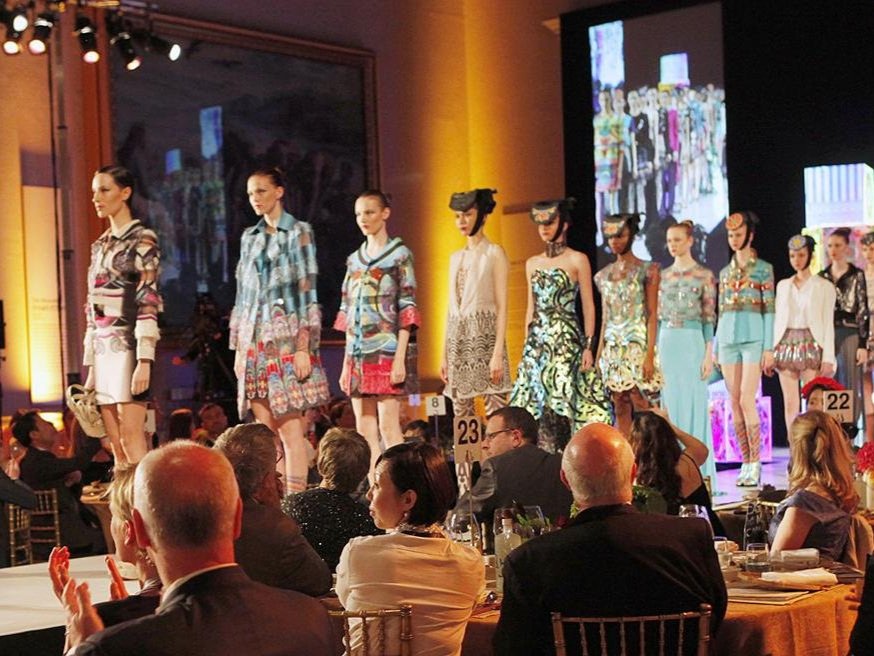Fake Fashion? How Generative AI Is Changing the Fashion Landscape
Olivia Little discusses AI’s foray into fashion and muses over why it fills her with immense dread.
Whether it’s using ChatGPT to help reword your CV for that coveted internship, being fed advertisements for stickers and stationery on Instagram, or using Google Maps to find the best coffee in Cambridge, artificial intelligence has become part of daily life. Now, generative AI has infiltrated a new sector — fashion.
In mid-October, Adobe made its foray into fashion with an interactive dress powered by generative AI: Project Primrose. The Project Primrose dress has since garnered significant online chatter about the possibilities of AI fashion and what its growing presence could mean for the future of clothing consumption.
In a video from Adobe’s annual Max conference, research scientist Christine Dierk models the tiled, AI-enhanced dress, showing off its capabilities such as changing patterns at the click of a button or swish of the hips. Using Adobe software such as Illustrator or Firefly alongside generative AI, users can design and upload patterns for the dress’s reflective light-diffuser tiles. Dierk emphasises that they seek to take the static nature of fashion and transition it into something dynamic and changeable.
Suddenly, generative AI’s presence in fashion has become undeniable. In this year alone, Vogue Business has released fifteen articles about generative AI in fashion – that’s only one less than the total amount of AI fashion-related articles they have released in the last four years. AI is evidently becoming a hot-button topic, and while media outlets may be discussing its academic implications, it has equally distinct impacts on culture and creativity. Introducing AI into physical fashion, beyond its current uses in the fashion industry such as for marketing or design, could allow for greater innovation for designers and wearers alike.
Fashion, however, is a key element of culture and from the Korean hanbok to the South Asian sari, cultural dress is an imperative part of human expression. It is the individualism of fashion as well as its communal effects which allows for self-expression and creates community. If everyone suddenly wears the Project Primrose dress, rather than individualizing ourselves via the structure or connotation of our clothes, we will only be defined by our patterns. Adobe admits that Project Primrose is still in the developmental stages, and consumers won’t see a market-ready version of the dress for years to come. Still, this begs the question, how is AI changing the fashion landscape?
In April of this year, the first AI Fashion Week merged tech and fashion. AI Fashion Week moved the runway online and promised the winners that they would send their pieces into physical production. While this might seem strange, this is one way that generative AI has already given way to more accessibility in fashion. Designers who may not have the opportunity to produce their designs and show them on a runway, especially at any fashion week around the world, have a space where they can showcase their creative talents and be recognized.
Despite my hesitation towards generative AI in physical fashion, it does offer positives in terms of environmental impact. The “non-emissive tiles” on the Project Primrose dress, according to the Adobe Research site, could allow the consumer to change their style constantly without having to purchase new clothes and discard old ones. The fashion industry is notorious for its egregious impact on the environment. A 2019 Business Insider report states that fast fashion is responsible for 10% of humanity’s carbon emissions, and in an age where climate change is threatening to obliterate our planet, something has to change. With AI fashion like Adobe’s dress, will fast fashion be a thing of the past? If we have the ability to change our looks on a dime, why would we need more than one garment? Is this the sustainable solution we’ve been looking for? In this era of technology, trends change quickly and without warning, leaving consumers clamouring to get their hands on the latest affordable fashions at the cost of pollution and poor labour conditions. Therefore, something like this ever-changing Project Primrose dress could propose a solution to the toils of the consumer and the impact of fast fashion.
With any new innovation, there are pros and cons. One of my greatest qualms with generative AI’s foray into fashion is its burgeoning influence on creativity. Does the “generative” element of generative AI take away that sense of unique human creation? Is there less value in art if it’s AI-generated? Why does a world where AI permeates even the clothes we wear instil me with immense dread?
I’m sure if someone in a petticoat circa 1890 came to 2023, they would be appalled that women can wear denim, men can wear dresses, and pretty much everyone has thought of dying their hair pink at least once. Sure, there is fear that comes with change, and the Project Primrose dress has the opportunity to alter and shape our fashion landscape more drastically than anything else has in recent memory. However, when it comes to the induction of AI into fashion, I believe that fear stems from a worry that creativity will be stunted.
While Project Primrose claims that fashion is static, and this stasis is what they aim to change, that statement is categorically false. Fashion is already dynamic and constantly evolving without AI. For example, in Iris van Herpen’s fall 2019 collection, Hypnosis, all her garments have movement. Her final dress, the Infinity dress, has several moving parts, giving the illusion of hypnosis and displaying the talent of the designer to incorporate moving pieces seamlessly. This collection pushes the boundaries of clothing’s “static” status. Further, Hussein Chalayan has showcased several transformable garments. In his spring 2016 collection shown at Paris Fashion Week, models wore water-soluble coats and had water showered over them. The fabric melted away to reveal two dresses. While an AI-enhanced dress is cool, the artistry displayed by these human-crafted ideas and the execution of the designers’ visions is doubly impressive.
With generative AI fashion, one could create any design and immediately have it dance across a garment. At the moment, Adobe’s dress can only display two shades of grey, but with more development, we could see the rainbow gliding across clothes. Adobe has admitted that the dress is in its early stages, and this was just a sneak peek into what is to come for wearable, generative AI fashion. Thus, does the AI-enhanced dress allow for more creativity, as Adobe promotes, or does it stunt it?
Part of fashion design, and any art form for that matter, is the implementation of human emotion and creativity. Even a plain white t-shirt has human creativity stitched into its seams. With generative AI, does that human essence escape clothes? At the end of the day, does the consumer even care?
One of the most prominent arguments about AI fashion is how the innovation of mechanical fashion is or is not minimising the creativity of designers. Gone could be the days of wacky structures like Viktor & Rolf’s artfully positioned dresses at 2023 Paris Fashion Week or crazy texture like the spray-on dress on Bella Hadid at Coperni’s show in 2022 or wild displays like Alexander McQueen’s robot-painted dress in 1999 (some examples of tech and fashion coalescing in a way that bolsters human creativity). While one can use AI creatively, and technological development is and of itself a creative act, AI-generated design loses the human touch that is integral to fashion design and consumption. Project Primrose feels, for lack of a better term, cold. Is that the future of fashion – cold-looking garments that are powered by artificial intelligence rather than bespoke by human beings? Rather than styling an outfit, will we just slip into our reflective tiles, press a button for a random pattern, and go? As someone who is invested in her clothes and the curation of her closet, I surely hope not.
AI can be creative; artists and designers use AI to enhance creativity. Generative AI in fashion can enhance accessibility and sustainability, but it should not forsake the creativity of the designer and consumer. Generative AI will never replace human creativity exhibited by the aforementioned designers and countless others.
All in all, honestly, as a self-proclaimed fashion girly, AI in fashion scares me, and I’m not the only one. On social media, the conversation has already compared this AI dress to those of The Hunger Games — on a TikTok of the dress, one commenter states, “Hunger Games Capitol vibes. Literally named Primrose.” Many have agreed that the garment is gaudy and unnecessary. It seems likely that clothing like Project Primrose will be ridiculously costly and result in a greater chasm between luxury and the pedestrian.
Do I think the Project Primrose dress is the next closet staple, like denim jeans or a white button-down? No, I don’t. However, the conversation it’s opened about AI in fashion is crucial to further tech development in clothing. There is a space for AI in fashion, and Project Primrose just makes it physically possible. Regardless of the future and whether or not we’ll all be wearing changing tiles soon, innovations like this material expand the way we can experience fashion. Personally, as of right now, I’ll stick to a puffer that I can transform by zipping off the sleeves before turning to AI-enhanced tiles.

